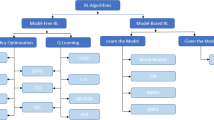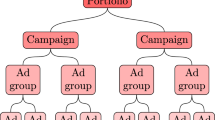Abstract
The article outlines a framework for online advertising budget allocation. First, it explores the empirical Bayes methodology for learning the effectiveness of different online ad placements – from historical data of varying quality. Second, it describes an analytical procedure for optimal budget allocation, which builds on risk management and reinforcement learning techniques.



Similar content being viewed by others
References
Barto, A.G. (1998) Reinforcement Learning: An Introduction, Cambridge, MA: MIT press.
Fader, P.S. and Hardie, B.G. (2009) Probability models for customer-base analysis. Journal of Interactive Marketing 23 (1): 61–69.
Fader, P.S., Hardie, B.G. and Lee, K.L. (2005) RFM and CLV: Using iso-value curves for customer base analysis. Journal of Marketing Research 42 (4): 415–430.
Lesnoff, M. and Lancelot, R. (2012) Package ‘aod’: Analysis of Overdispersed Data. R package version, 1.
Lora, M.I. and Singer, J.M. (2011) Beta-binomial/gamma-Poisson regression models for repeated counts with random parameters. Brazilian Journal of Probability and Statistics 25 (2): 218–235.
Richardson, M., Dominowska, E. and Ragno, R. (2007) Predicting clicks: Estimating the click-through rate for new ads. In: Proceedings of the 16th International Conference on World Wide Web, New York: ACM, pp. 521–530.
Sahai, H. and Khurshid, A. (1993) Confidence intervals for the mean of a Poisson distribution: A review. Biometrical Journal 35 (7): 857–867.
Wang, X., Li, W., Cui, Y., Zhang, R.B. and Mao, J. (2011) Click-through rate estimation for rare events in online advertising. In: Online Multimedia Advertising: Techniques and Technologies 1, Hershey, NY: Information Science Reference.
Author information
Authors and Affiliations
Additional information
1recently a manager of marketing analytics at BlackRock, where he was responsible for marketing campaign reporting and led multiple analytics projects including evaluation of marketing effectiveness, marketing mix modeling, optimization of advertising spend and customer lifetime value monitoring. He holds a bachelor’s in business economics and international relations from Kyiv National Taras Shevchenko University, and a Master of Science in marketing from Columbia Business School. He is currently pursuing an MS at Stanford University in the field of decision analysis and artificial intelligence.
Appendices
Appendix A
Beta function
The Beta function B(α, β) is defined by the integral

Alternatively, the Beta function can be expressed in terms of Gamma functions.


Appendix B
Entropy calculation
We measure spend diversification using the entropy formula from information theory, where P(x i ) indicates a proportion of budget to be spent on a particular ad placement.

Rights and permissions
About this article
Cite this article
Tkachenko, Y. Optimal allocation of digital marketing budget: The empirical Bayes approach. J Market Anal 2, 162–172 (2014). https://doi.org/10.1057/jma.2014.14
Received:
Revised:
Published:
Issue Date:
DOI: https://doi.org/10.1057/jma.2014.14




